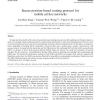ENTCS
2008
13 years 11 months ago
2008
Mobile Ad-hoc Networks (MANETs) allow wireless nodes to form a network without requiring a fixed infrastructure. Early routing protocols for MANETs failed to take security issues ...
COMCOM
2004
14 years 8 days ago
2004
Routing of packets in mobile ad hoc networks with a large number of nodes or with high mobility is a very difficult task and current routing protocols do not really scale well wit...
ADHOC
2004
14 years 9 days ago
2004
The 1990s have seen a rapid growth of research interests in mobile ad hoc networking. The infrastructureless and the dynamic nature of these networks demands new set of networking...
JCM
2006
14 years 12 days ago
2006
Quality of Service support plays a major role in the Next Generation Internet. QoS routing protocols must cope with service differentiation to enhance this support. This paper prop...
JNW
2008
14 years 12 days ago
2008
Cross-layer mechanism, for which a protocol locating at a given layer uses information issued from other layers, may enhance the mobile networks performance. Some of those mechanis...
JCST
2008
14 years 12 days ago
2008
Routing is a fundamental problem in wireless sensor networks. Most previous routing protocols are challenged when used in large dynamic networks as they suffer from either poor sca...
IJIPT
2006
14 years 13 days ago
2006
: Anycast is a new IPv6 feature that supports service
COMCOM
2006
14 years 14 days ago
2006
A number of routing protocols [1] have been proposed for wireless sensor networks in recent years. Considering energy-efficiency as the primary objective, most of routing protocol...
ADHOC
2007
14 years 17 days ago
2007
In large and dense mobile ad hoc networks, position-based routing protocols can offer significant performance improvement over topology-based routing protocols by using location...
SIGCOMM
2010
ACM
14 years 19 days ago
2010
ACM
Recent studies have shown that the current primitives for connecting multiple routing protocol instances (OSPF 1, OSPF 2, EIGRP 10, etc.) are pervasively deployed in enterprise ne...



